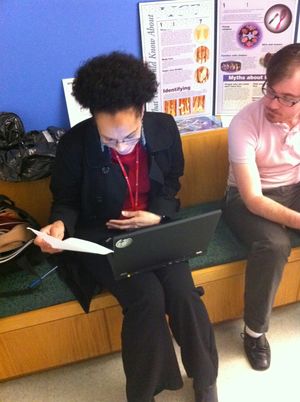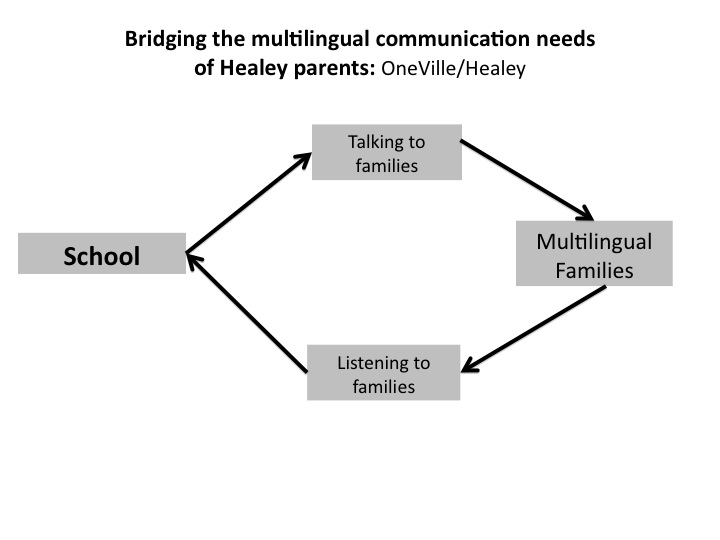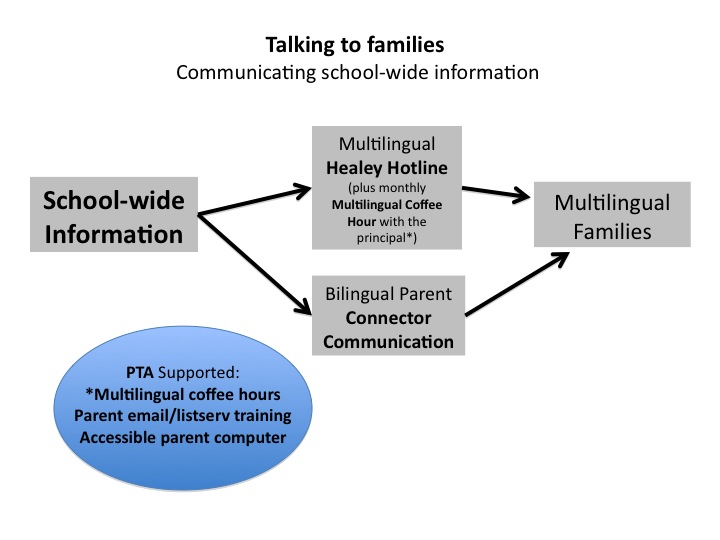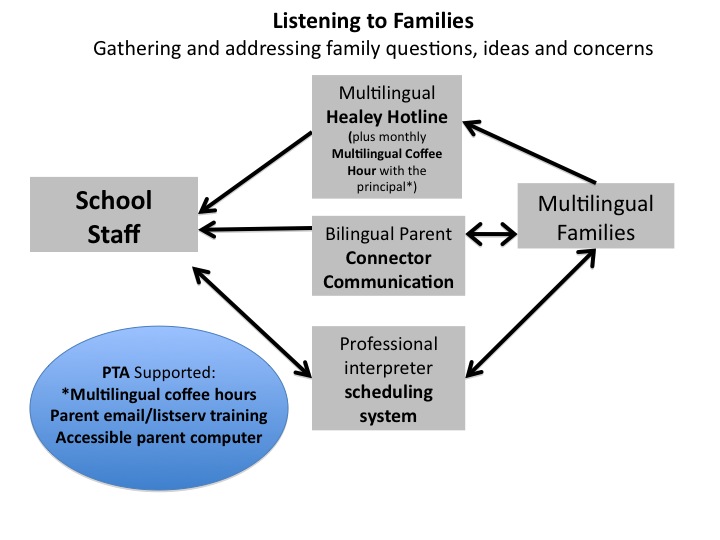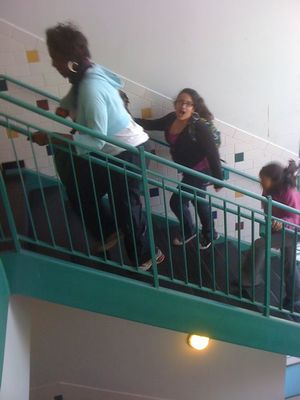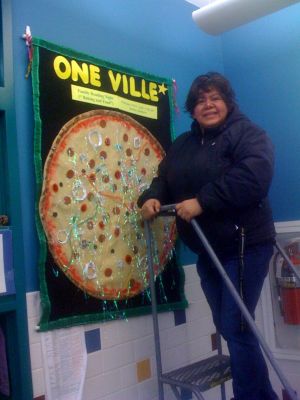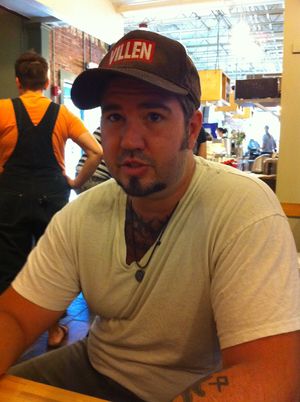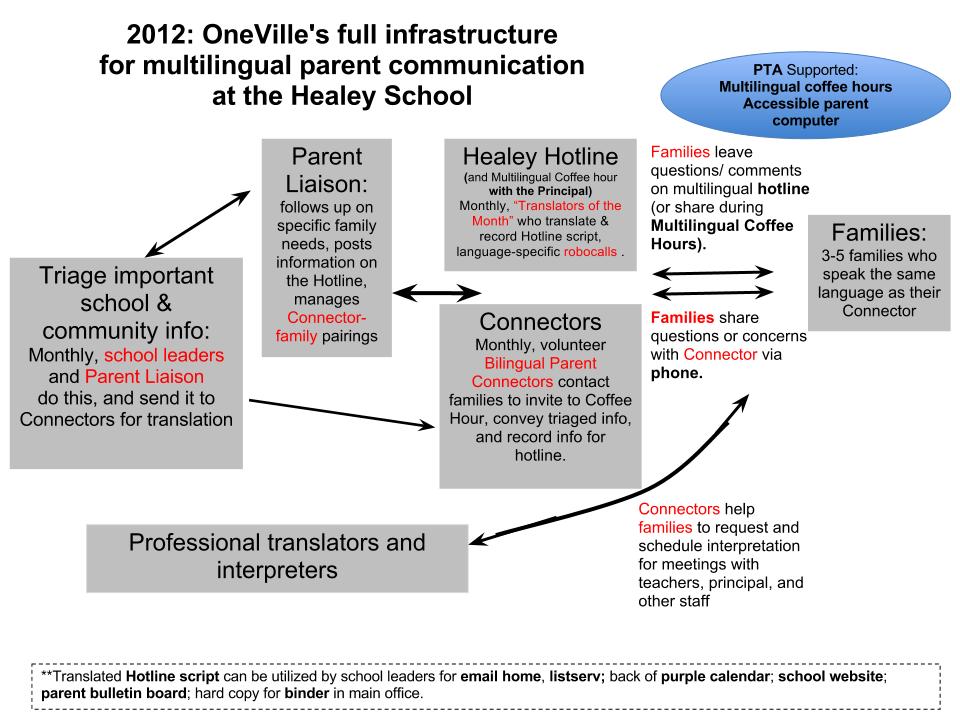Overview and key findings: Schoolwide toolkit/parent connector network
From Oneville Wiki
Written by Mica Pollock (2009-11 work), Jedd Cohen, Tona Delmonico, Gina d'Haiti, and Ana Maria Nieto for the Parent Connector project, with input from parents across the Healey School (particularly Consuelo Perez, Lupe Ojeda, Sofia Perez, Maria Carvalho, Ivanete Calmon, Veronaise Chaiki, Will Thalheimer, Tracy and Dave Sullivan, Adriana Guereque, Maria Oliveira, Manoj Archarya, Claudia Ramos, and Michele Arroyo-Staggs).
Click here for the Summary on this project; click here for the Expanded story on this project.
Communication we hoped to improve
What aspect of existing communication did we try to improve, so that more people in Somerville could collaborate in young people's success? How’d it go?
- (Who was involved in the project and how was time together spent? What did the project accomplish?)
At Somerville’s Healey School (K-8), as in many U.S. schools, parents hail from across the globe and speak many languages. And as in many schools, language barriers often keep parents from being equally informed about school issues, events, and even educational opportunities. So do disparities in tech access, tech training, and time -- as well as gaps in personal relationship and connections. Lots of people at the Healey talked about needing better school-home and parent-parent communication, particularly to fully include immigrant families, families without computer access/knowledge, families with low literacy skills, and families who couldn’t or didn’t show up often in person at the school.
So, we operated from a central principle already core to the Healey School: a child can’t be educated as effectively if parents aren’t included as key partners in the project. So, schools should ensure access to school information and pull all parents into dialogue about improving their children’s school experience. Info out, input in.
The Healey School enrolls a full U.S. range of families with different communication habits and needs. Some email the principal and Superintendent regularly. Some parents have no computers and no internet. A listserv has long enrolled only some. Robocalls home go in four languages; handouts home often don't. For many, parent teacher conferences require interpreters, and accessing those interpreters itself is a structural communication need, in part because some parents don't know how to access the service and in part because many of the parents who need interpretation are incredibly busy - sometimes working multiple jobs. One Portuguese-speaking dad worked such long hours he didn't even have time to come to school to post a sign saying he wanted to find and pay another parent to help him drive his daughter to school. In addition, parent and staff efforts to make an appointment to talk to one another with interpretation services can also get lost in the crush of meeting student needs: One Spanish-speaking parent told us she’d tried a number of times throughout the year, unsuccessfully, to meet with her child’s teacher in person.
In contrast, some families, particularly English-speaking families, volunteer many hours in classrooms during the school day and so get regular access to their child’s teacher. Many such families also are on committees that meet after school and so, take the opportunity then to contribute ideas to the school. Over the years, we saw that families who saw each other regularly at face to face school events also made friends, joined listservs, signed up in directories, and showed up at next events.
As we describe below and in the Expanded story , when we began in 2009 we first worked on several strategies to support diverse parents to share ideas and information, and to build relationship (Reading Nights, Parent Issue Dialogues). Then, we focused on the challenge of multilingual communication, because language barriers particularly have excluded many Healey parents from full participation. The Multilingual Coffee Hour, begun in 2009, was our first explicitly multilingual effort. Then, in 2010-11 and 11-12, the Parent Connector Network has focused fully on parents reaching out to other parents who speak the district's three main languages other than English: Spanish, Portuguese, and Haitian Creole. We've also been working to build personal relationships between bilingual parents and recent immigrant parents, in order to bring more voices into school debates and more people into school events and leadership -- as well as help the school respond more quickly to parent needs.
Begun in Winter 2010, the Parent Connector Network now supports translation and parent-school relationships, by connecting bilingual parents (“Connectors”) to more recently immigrated parents face-to-face, and via a phone tree and multilingual hotline. The Parent Connector Network is now run largely by parents and community members, with coordination efforts by a OneVille community staff member handed to school staff; Connectors continue to innovate the Network model in partnership with school administrators and staff and with the blessing of District administration. Our hope is that new part-time Parent Liaisons being hired by the District for schools like the Healey will also help the volunteer Connectors coordinate their work.
Beginning in spring 2012, Connectors started to use a multilingual call-in hotline (which our MIT friend Leo Burd made for us with open source VOIPDrupal software) to share out school information, to help ensure that information reaches English language-learning families and families with fewer tech and literacy skills. As Connector relationships and incoming parent requests and ideas grow in the future, Connectors may use Google forms to gather and prioritize school information. (Google forms are simple online forms that allow multiple people to input information that gets stored in a basic online database.) We tried that strategy briefly in 2010-11 but didn't yet need it: so far, Connectors have been able to handle individual parent needs by simply relaying requests and issues to appropriate staff.
By spring 2012, we were working with 5 Spanish-speaking Connectors, and 1 Portuguese-speaking, 1 French-speaking (for Haitian Creole-speaking families), and 1 Hindi and Nepali-speaking Parent Connector. Each Connector is asked to call 3 - 5 other families once a month to share key information from the principal/school and to ask questions about any issues parents are facing. The Connectors are also on-call to parents during the school year to help them find answers to both general and specific questions or concerns they may have about their child’s school. (e.g., some Connectors have received calls about issues like summer school enrollment, or about how to reach the district’s Parent Information Center to enroll a new cousin in a school.)
That spring, we also successfully tested a strategy of having volunteer Connectors wear "badges" as informal interpreters or contacts available to any school parent at the beginning of some school days, to enable more parent-parent connections and a clear route to get "on demand" interpretation for early morning conversations with staff.
Connectors also are starting to act as volunteer “Translators of the Month” for each main language group, helping to translate a monthly set of school information for our Healey Hotline. This translated material can then be used for other school media (listserv, handouts, flyers, etc.). These Translators won't translate the official information the school or district is legally required to make accessible to all parents. (Civil rights law requires that all parents have an equal opportunity to access important school information; some such information involves specialized lingo and definitely requires formally trained professionals.) But so far, volunteers and, stipended Connectors ($15/hr) are willing to help produce an additional stream of translated material for the school. (As we describe below, we later found that in-person support to access interpretation helped ELL families to feel comfortable meeting with their teachers.)
In fall 2011, we also successfully argued for creating a part-time liaison role (five hours per week paid by the school) for staff already employed by the school to support the Connector Network. The liaison role provides a range of crucial supports for the network that a school employee is best positioned to do. For example, the liaison can help summarize school information for translation by the translators of the month, summarize parent needs for the administration, recruit new parents at in-school events, and respond appropriately to serious or ongoing parent needs -- beyond what a volunteer parent can or should do. The role requires not only a strong connection to local immigrant communities but skills in tracking and managing multiple relationships and projects simultaneously. Several staff members tried the role, and one particularly willing staff member volunteered her time.
The role is currently distributed across the volunteer staff member, several parent leaders, and a OneVille community staff coordinator. Our final goal has been to transfer these responsibilities away from OneVille paid staff and fully onto staff and parent leadership, and we spent the spring 2012 semester building the staff skills to do this, supporting parent leadership, and piloting the full combination of multilingual hotline, connectors, and parent liaison work.
See the bottom of this Overview page for the final set of "components" we were implementing by spring 2012.
Our work, and our ¡Ahas!
What was the basic groundwork needed to support the current work? How did the project change and grow over time? At this point, what are our main ¡Ahas! about improving communications in public education? What communication and implementation ¡Ahas! and turning points did we have over time?
Work informing the Parent Connector Network began in a 2009-10 series of Reading Nights and Parent Dialogues, and a Multilingual Coffee Hour that continued in 2010-11 as part of the Parent Connector Network infrastructure. We learned a huge amount in that work and we built relationships that enabled the development of the Parent Connector Network. Click here for the full backstory!
As a multilingual group of parents and staff (a few of whom speak only English), it has taken us two years to fully understand:
1) The barriers in the way of adult English learners' participation in English-dominant schools;
2) The sort of systemic communication "infrastructure" necessary to include more immigrant parents as partners in the project of supporting young people;
3) How to find and recruit people with the skills needed to implement the infrastructure, and how a volunteer-based project can delegate responsibility across available community members (and, stipend key people for leadership roles.)
Some main ¡Ahas! over time have been these:
¡Aha! Overall, we’ve learned that committed and diverse parents can be expert innovators of communication infrastructure for including all parents because they have a full understanding of communication barriers.
¡Aha! In a multilingual school and district in particular, local bilingualism is a key resource for strengthening communications and relationships between families and educators. The key is tapping local bilingualism in strategic ways.
¡Aha! To fully engage all parents in a multilingual and diverse school, each effort to engage parents requires multiple efforts to make communication fully inclusive. Barriers to full inclusion exist every step of the way. So, we have come to think in terms of creating a full "infrastructure" for schoolwide communication (and low-cost translation and interpretation in particular) in a school. For example, to reach parents across tech access barriers, a Reading Night linking three kindergarten classrooms and a Special Education classroom required advertising the event not only using the school's listserv, but also via paper handouts and displays on the kindergarten hallway's wall. Including all parents during the event also required actively tapping parents' own bilingualism, by engaging parents in translating conversation in multilingual groups. To get parents to a Multilingual Coffee Hour or PTA Night event, we needed to learn how to record multilingual invitation messages on the school's "robocall" system; then, we had to experiment with which recorded voices made the event seem most appealing to parents. We also experimented with recording targeted robocalls to one language group at a time, instead of recording all four at once. This was because on parents' home answering machines, robocalls often cut off after the first two languages -- and because Portuguese and Haitian Creole translations were always last after English and Spanish, those languages often didn't get heard.
Before we started working on the Parent Connector Network in Winter 2011, we worked with families and teachers in other efforts to improve parent-school and parent-parent connections. Most of all, we had to build relationships across parents and staff who cared deeply about including everyone. These friends became key partners in innovation.
Communication and implementation ¡Ahas!, and turning points!
We had many ¡Ahas! in sequence on this project over two years. To read the full story of the efforts that gave us these ¡Ahas!, click here!
Additional ¡Aha!s about schoolwide communication included the following.
READING NIGHT AHA:
Reading Night was about building initial relationships and friendships between parents as much as it was about sharing reading tips. These relationships became crucial to all of the work we all did together at the Healey over the next three years.
MULTILINGUAL COFFEE HOUR AHAS:
The Multilingual Coffee Hour started in 2010-11 and then became a key piece of the Parent Connector Network infrastructure the following year. We realized:
¡Aha! Making parent gatherings explicitly multilingual encourages speakers of languages other than English to ask questions and offer opinions. In addition, multilingual events -- events where people take the time to translate for one another and, encourage others to speak in their own language -- also help parents and staff appreciate their peers' language talents.
PARENT-PARENT ISSUE DIALOGUE AHAS:
In 2010-11, several Parent-Parent Issue Dialogues helped a number of Healey parents debate a fundamental and controversial issue about their school's future: integrating several historically separate student programs. We realized the following in these efforts:
¡Aha! Many parents have few or no opportunities to talk to each other or to decisionmakers in organized settings, about major issues in their school. This means that their ideas and energy for improvement go untapped. Parents with tech access and knowledge (e.g., parents on a school listserv), and English speakers, are often far better informed and included in such debates.
- *TURNING POINT: With the Healey in the midst of integrating several historically separated programs, parents focused for 2010-11 and then 11-12 on improving infrastructure for schoolwide communication -- and particularly, on including immigrant parents in the loop of school information and input. We designed the Parent Connector Network.
- *¡Aha!/TURNING POINT: Try focusing on the most-blocked communication first. In this case, after trying a number of efforts to link parents at the school in dialogue (another important barrier at the Healey was the need to build relationship between newer, higher-income English-speaking Somerville residents and older, lower-income English-speaking Somerville residents), we focused on addressing the language barriers making communication particularly difficult.
PARENT CONNECTOR NETWORK AHAS:
In addition to the main ¡Ahas!above, we realized the following:
¡Aha! Innovation requires experimenting with communication solutions, even if strategies aren't guaranteed to work. In our case, we tested a number of solutions for getting school info “out” and parent input “in” across boundaries of language, and building relationships across those boundaries.
¡Aha! While asking how schools get info out, we also have to ask how they get input in. How do schools hear about and then respond to parents’ ongoing problems and concerns?
¡Aha! School-home communication relies in part on parents building relationships and connections with other parents. Parents said they came to PTA night or other such school events because someone they knew invited them -- that a friendly face would be waiting at the event ("Come to this event, and I'll be there to support you"). Tech tools like phones, hotlines, or listservs can amplify and extend that ultimate resource for parent-parent connection: relationship-building. One of our Connectors had an ¡Aha! that others echoed across the OneVille Project: “My main conclusion is that relationships matter and they are what makes everything work.”
¡Aha! Creating “infrastructure” that makes interpretation and translation more efficient requires figuring out who to pay for what. The people who share a school can, will, and should volunteer their time to help the school and other families communicate. But only up to a certain point. When workload is too heavy or when professional skills are necessary -- and, to embed the project into the core work of the school -- projects need to pay staff whose job it is to help include all parents. For example, communication on individual parents’ serious personal needs will have to be covered by paid staff, freeing volunteers to be friends, info-sharers and links TO paid staff. But making translation mechanisms more efficient (e.g., trying a hotline to get info to many parents at once; triaging info to be translated by volunteers or stipended parents on the hotline) can save staff time that otherwise is spent explaining things repeatedly.
Some key turning points in developing the Connector role:
By late January, 2012, we began to feel that phone calls pairing Connectors to a subset of families weren't enough. The Connector Network had grown to a total of nine bilingual Connectors paired with dozens of families for phone calls "out," but parents weren't asking much of their Connectors, and putting effort into getting parents to school-based events started to seem less profitable than perhaps scheduling events where parents themselves already were. Parent Connectors met together to brainstorm next steps on information-sharing and relationship-building:
TURNING POINT: In spring 2012, we pursued a deepened focus on face-to-face, rather than phone-to-phone connection. The Connectors brainstormed several sites of rich communication in daily school life to build on next:
- Often, we saw ELL (English language learning) parents waiting before and after school to ask questions of a single bilingual staff member. To support these face-to-face connections, we found it useful to stipend three connectors to spend additional hours before and after school, to help connect parents directly to the staff member they wanted to talk with.
- Parents also find that communication about their child’s classroom, rather than about the whole school, is much more engaging and rewarding. So next year, Connectors will begin to pair up with grade level teams or even with particular "classroom parents" to share classroom-level information with families in their child's class or grade.
- Next year, Connectors plan to hold monthly multilingual coffee hours outside of the school, at places where parents already gather -- e.g., at the Portuguese Club, the Haitian Coalition, or the Mystic Housing Project.
Some key turning points in developing the Connector Network's technological infrastructure:
- Leo Burd, a new friend from MIT's Center for Civic Media, finished an improved version of our hotline in spring 2012. We stipended three Connectors each month to translate the info update into three languages and record it on the hotline. The Connectors began to call families simply to let them know the hotline was a resource, and Connectors sent out a robocall in the school's main languages to announce the hotline via the school’s automatic messaging system. We think the hotline may relieve the Connectors of having to share schoolwide information with families. This, in turn, would allow Connectors to focus all their energy on more personalized outreach.
- During the 2011-12 schoolyear, we also created a Googledoc of basic contact info/citywide parent services info all Connectors need to know: https://docs.google.com/document/d/15eF7hZP5DUCwl92WTYcOrElUWDICTdx69WjDgs8UfOI/edit
- We helped Purnima Vadhera, the 2011-12 principal, make a fall parent communication form (see File:Healey School Communications Sign-Up Form 2011.pdf) that will help parents sign up to get a Connector, make it easier to get parents’ phone numbers, and allow parents to record their preferences for contact (texting? listserv? classroom listserv?) and indicate whether they need email training.
- Finally, we began teaming up with parent leaders and local community organizations to explore offering computer, internet, and email listserv training to parents. In a multilingual community where not everyone uses computers, some lack access to information because of translation gaps and some because of a gap in basic tech knowledge. We learned early on in our work in Somerville that the problem for parents was often not necessarily one of computer access (the nearby housing project has many computers) as much as one of training. Even English-speaking parents in the school’s magnet program didn't know how to get on its listserv; many parents didn't know how to use a computer's basic functions. Now that the school’s programs have merged and the Healey school is creating a schoolwide listerv, these issues will rise to the fore. And having parents develop and participate in a multilingual school listserv could be a powerful new frontier for parent inclusion.
In our 2011-12 work, we've also gleaned some very practical lessons about how to implement the Parent Connector infrastructure:
- ¡Aha! Bilingual volunteers may engage parents more effectively in school activities if they reach out to parents with a specific offer or request rather than a generic offer that requires parents to actively seek their help. For e.g., the generic offer "to provide school information and help answer your questions whenever you need it" may be less effective than “I’ll come with you to parent-teacher conferences next week,” or “Come to a Brazilian dance performance at the school on Friday."
- ¡Aha! In order to engage ELL families with the most excitement in schools, a focus on traditional school activities that simply include parents in “business as usual” (i.e., Parent-Teacher conferences) can be complemented by the creation of school activities that actively honor these families’ languages and lives, e.g., a monthly Multilingual Coffee Hour that actively invites multilingualism, or an International Week that actively incorporates heritage activities in the classroom and after school.
- ¡Aha! Parent availability changes, so it's important to develop a strategy for recruiting new parents to school efforts early and often. In addition to doing outreach and holding multicultural events at the beginning of the school year, when parents' hopes and energy are high, recruitment can also target parents whose children are in kindergarten, help the families become acclimated, and eventually tap them as leaders and mentors to next parents.
Our products: Concrete communication improvements and next steps
We are proud to say that the Parent Connector vision and project is now part of the Healey School's school site plan. We have a core of volunteer Connectors reaching parents in-person and via phone, and lead Connectors in Spanish and Portuguese. Two current/former Harvard graduate students, Jedd Cohen and Ana Nieto, worked as support coordinators in 2011-12 to support the effort while it solidified. The 2011-12 principal, Purnima Vadhera, worked with us to submit a contract to Human Resources for the five hrs/week liaison position to handle parent needs forwarded by the Connectors -- and to oversee the multilingual communication process we’ve come up with. While we waited for the liaison position to be approved, we filled in the gap by combining Jedd and Ana's efforts with that of a bilingual staff member, Adriana Guereque, who volunteered her time to follow up on individual family needs, and a very engaged Healey parent, Laura Pitone, who triaged monthly information and ensured that the district translated it.
Together, the Connectors (with advice from many other parents and staff consulted over the two years) fleshed out a list of components of the necessary “infrastructure” for multilingual communication. The Connectors themselves have become seen as a key local resource, as people willing to be on call to answer other parents' questions in their language and to (monthly) share information that requires more explanation:
In sum, this year we piloted the full infrastructure we developed for multilingual communication. We:
- a) piloted our Parent Connector Network, in which bilingual parents make monthly contact with immigrant and low-income families to get information to and input from them; Connectors also invite parents to our Multilingual Coffee hours and to the hotline.
- b) tested a model where a Parent Liaison and Lead Parent Connectors develop and implement the details of face-to-face and phone-based outreach, follow up on specific parent needs, and help parents access interpretation;
- c) piloted initial use of our open source hotline, on which parent “Translators of the Month” translate and record information about events, issues, and opportunities.
We're pleased to announce that next year the Healey School will have a district-funded, part-time parent liaison to manage volunteers, reach out to ELL families, and oversee a new Welcome Center, designed to provide a welcoming space at the Healey to all families. We're working with the incoming Principal, Jill Geiser, to build on our insights from the Connector Network as she designs the responsibilities of this new position.
Final thoughts
Overall, we’ve been exploring a cost-effective hybrid of volunteer efforts to connect parents to other parents and “infrastructure” that includes paid school staff. As mentioned above, a key issue we addressed in the Parent Connector Project was the line between translation/interpretation that bilingual parents can and will do as volunteers to serve their community, and when the district has to pay professionals. A parent in a federally funded district has a civil right to translation and interpretation if she needs it to access important parent information (including at parent-teacher conferences). But all districts are strapped for money and bilingual skills are true community resources. How to tap those resources without overtaxing volunteers, and without asking volunteers to do the sort of work that really should be done by paid professionals?
In our case, we isolated an aspect of the infrastructure that volunteers couldn’t cover and argued that a bilingual staff member be employed part-time to cover it. We reasoned that volunteers shouldn't be asked to ensure that parents get Special Education services for their children or be responsible for requesting paid interpreters from the district. Paid staff in any district should be on top of such “case management.” But volunteers may be able to do something no staff member can do so easily: build friendships that glue parents in as partners in student success.
Questions to Ask Yourself if You’re Tackling Similar Things Where You Live
What big issues would we recommend others think about in their own attempts to improve communications in public schools? Contact us to talk more!
Consider the current and needed schoolwide communication infrastructure at your school:
- ➢ Can everyone who needs to get and share important school information, get and share it? Do parents know who to talk to when they need information?
- ➢ Where do you put school information so that everyone in the school can see it?
- ➢ How do you share parent ideas around the school?
- ➢ What system do you have for translation and interpretation, in particular?
- ➢ How can you tap local bilingualism, either paying people to translate material or organizing bilingual volunteers to pitch in on translation and interpretation in a way that doesn't take too much of their time?
- ➢ How can you build on parent-parent relationships to pull all parents into school events and conversation?
- ➢ What tech training do parents need in order to get information? How could you help all parents get this training?
- ➢ Which efforts at parent information should be a task for school staff rather than volunteers?
Technological how-tos
Here's where we describe "how to" use every tool we used, so that others could do the same. We also describe "how to" make every tool we made!
We’re using a Googledoc as one organized place for a Connector list of resources relevant to Somerville's immigrant families: https://docs.google.com/document/d/15eF7hZP5DUCwl92WTYcOrElUWDICTdx69WjDgs8UfOI/edit
See http://www.google.com/google-d-s/tour1.html for instructions on starting a Googledoc. (Note: to use googledocs, users need gmail accounts to view any googledocs that are set as "private.")
While some school systems get parents' permission en masse to release their information to other parents in a School Directory, administrators asked us to take care to ask each parent's permission for releasing information to their Connector (see Expanded story on this aspect of the project). We use Editgrid for secure lists of approved parent contact info for Connector use. See editgrid.com for instructions on starting and using Editgrid's spreadsheets. (At this time of this writing, Google spreadsheets don't allow sorting by any column, whereas Editgrid spreadsheets do.)
We used Google Translate for some first-pass translations of material for the hotline or other school channels, but bilingual parents still had to correct the translations. See http://translate.google.com/support/ for tips on using Google Translate.
With the Healey's principals, Connectors have experimented with recording translated robocalls home, using Connect-Ed, the district’s existing system for sending calls to many families at once. As described in the Expanded story, in our case, we learned to target robocalls to one language group at a time instead of recording all four at once, because robocalls often cut off after the first two languages (and because Portuguese and Haitian Creole were always last). We also asked Connectors to record some robocalls in their friendly parent voices, which drew some parents to PTA night!
On the hotline: Local technologist Seth prototyped our first hotline, and in spring 2011, we were still recording voices or saving audio files onto Seth's computer -- see photo of Maria and Seth above. At that point, Leo Burd from the Center for Civic Media then made the professional version that we began piloting in 2011-12. (Here's Leo talking about his VOIPDrupal software: http://www.youtube.com/watch?v=C8NCRLCdPno&noredirect=1). See here for Leo's explanations of the programming. Leo's goal is for the software to be developed quickly by any community that wants to use it.
Click here for the Summary on this project; click here for the Expanded story on this project.
